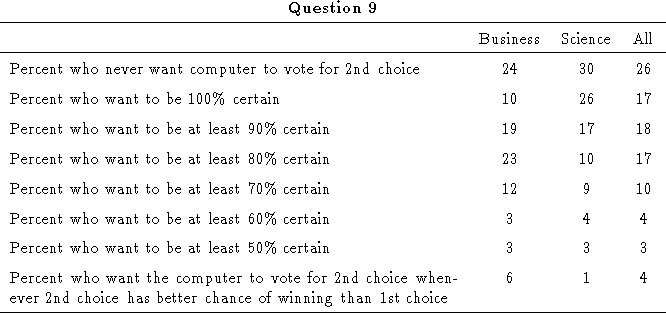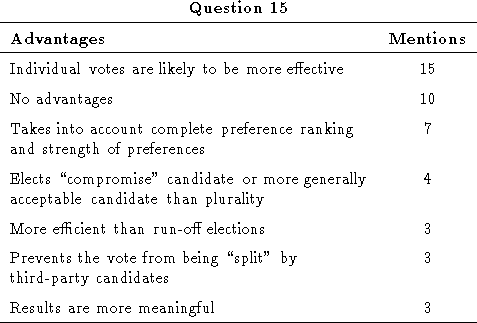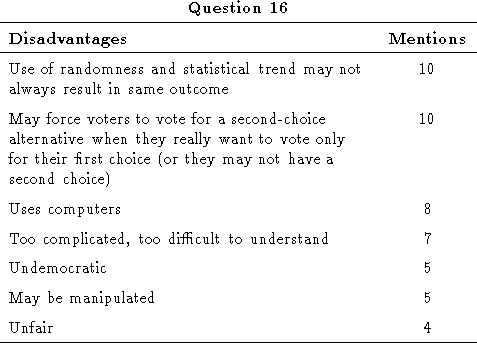
In this section we present a study we conducted to determine the acceptability of DSV by members of a relatively well-educated population. Clearly a more general study is necessary to determine the acceptability of DSV for public elections. However, this limited study provides insights into some of the reactions to DSV that are likely to be encountered in any voter population.
One hundred seventy-one Washington University students were surveyed to gauge their attitudes towards declared-strategy voting and to collect preference data for use in simulations. Survey forms were distributed over a two-day period during a Summer semester in first-semester physics and chemistry classes in the College of Arts and Sciences and in MBA classes in the John M. Olin School of Business. In each class, the survey administrator collected the surveys as students completed them, about 5 to 10 minutes after they were distributed. The survey instrument is reproduced in Appendix A.
A total of 96 business students and 75 science students completed the survey. The business students were mostly graduate students, often with professional experience. The science students were mostly undergraduates majoring in science or engineering, or planning to attend medical school.
The first question asked whether respondents had attended school full time during the Spring 1996 semester. All respondents who had attended school full time during the Spring 1996 semester were classified as full-time students. The remainder were classified as part-time students. The distribution of full-time and part-time students was as follows:

Overall there were few significant differences between the responses of full-time and part-time students or between the responses of business and science students.
Questions 2 and 3 collected preference data for use in DSV simulations. These simulations will be discussed in the next section.
Question 4 asked respondents whether they had voted in a student government election during the 1995-96 school year. Only 25% responded affirmatively. As the following table illustrates, most of the student government voters were science students. This may be attributable to the fact that at Washington University, undergraduates are more likely to vote in student government elections than graduate students, and more of the science students were undergraduates.

Question 5 asked respondents whether they were registered to vote in the United States. As the following table illustrates, business students were more likely to be registered than science students, possibly due the fact that the business students were generally older than the science students.

Question 6 asked respondents to rate five potential US Presidential candidates on a scale of 0 to 10. These rankings were subsequently used in the simulations described in the next section. In addition this question provided a context for the remaining questions.
Questions 7 and 8 were introduced as follows:
Most elections in the US use a voting system called plurality rule. In this system voters mark a single choice on their ballots, and the candidate with the most votes wins. Imagine that instead of using plurality rule, the 1996 US Presidential ballot asks voters to rate each candidate as you did in Question 6. The candidate with the highest rating would be a voter's first choice. One way to tally this kind of ballot would be to have a specially programmed computer analyze each ballot and cast a vote that will maximize the influence of that ballot.
Question 7 then described the following scenario:
Suppose that on the ballot described above your 1st choice ends up coming in last, as shown in the table to the right. However, your 2nd choice comes in first. Your 5th choice comes in a close second. Now suppose that when your ballot was counted, the computer cast your vote for your 2nd choice because it was unlikely that your 1st choice could win and your 2nd choice needed your vote to beat your 5th choice. How satisfied would you be with the performance of the computer in this situation?
On a scale of 1 to 5, where 1 indicated extreme dissatisfaction and 5 indicated extreme satisfaction, the mean response was 2.85 with a standard deviation of 1.26.

Question 8 described a scenario identical to the one described in question 7, with the exception that the 5th choice ends up winning. On a scale of 1 to 5, where 1 indicated extreme dissatisfaction and 5 indicated extreme satisfaction, the mean response was 2.50.

The results of questions 7 and 8 indicate that overall respondents were slightly dissatisfied with the way the computer cast their votes. The fact that there was more dissatisfaction expressed in response to question 8 (where the 5th choice won) than in response to question 7 (where the 2nd choice won) suggests that respondents had difficulty evaluating the voting procedure separately from the election outcome. Further analysis reveals 55% of respondents indicated the same level of satisfaction in response to both questions, 32% indicated more satisfaction in response to question 7, and 12% indicated more satisfaction in response to question 8. It is not clear why a respondent would be more satisfied with the performance of the computer in question 8 than in question 7. It is likely that those who gave that type of response did not fully understand the question. However, removing these respondents from the analysis of this or other questions does not significantly impact the results.
Question 9 asked ``How certain would you want to be that your first choice was not going to win before you supported the computer voting for your second choice?'' Overall, 74% of respondents supported the computer voting for their second choice under some conditions. The results of this question showed some significant differences between these groups of business and science students, with the science students more reluctant to let a computer decide to vote for their second choice.

Note that the last response option for question 9 is essentially the
bandwagon option discussed in Chapter ![]() .
.
Question 10 asked ``How easy or difficult do you find it to understand declared-strategy voting?'' On a scale of 1 to 5, where 1 indicated extremely difficult and 5 indicated extremely easy, the mean response was 3.52.

Question 11 asked voters to compare the fairness of DSV and plurality voting. This question was designed to get a gut-feeling reaction, and no definition of fairness was given. On a scale of 1 to 5, where 1 indicated that DSV is much more fair and 5 indicated that DSV is much less fair, the mean response was 3.25. Business students were more likely than science students to find DSV more fair than plurality.

Questions 12, 13, and 14 asked respondents how they would feel if DSV were adopted for US Presidential elections, student government elections, and the tallying of university surveys, respectively. Respondents had the strongest feelings about Presidential elections, with over 40% expressing indifference (a 3 response) about the use of DSV for student government elections or surveys. On a scale of 1 to 5, where 1 indicated extreme dissatisfaction and 5 indicated extreme satisfaction, the means for the three questions were 2.52, 2.93, and 2.88.

Overall 33% of respondents indicated less satisfaction about the prospect of using DSV for Presidential elections than for student government elections and 34% indicated less satisfaction about the prospect of using DSV for Presidential elections than for surveys. It is not surprising that respondents had stronger opinions about the Presidential election than about student government elections, especially considering that the majority of students did not report voting in a student government election in the past year. It is somewhat surprising that students were slightly less satisfied by the prospect of using DSV for surveys than for student government elections. However, this is likely due to the fact that there was more indifference about student government elections than about surveys. Overall, students were slightly dissatisfied about the prospect of using DSV in any of these contexts. This indicates that voter education would be essential before this population was likely to accept DSV (indeed extensive voter education has been necessary to adopt most new types of voting systems). However, it also indicates that this population is not completely set against using DSV.
At the end of the survey, respondents were asked ``In your opinion, what are the advantages of declared-strategy voting?'' and ``In your opinion, what are the disadvantages of declared-strategy voting?'' Only 39% of the respondents answered one or both of these questions, and it was difficult to tell what some of the respondents meant by what they wrote. However, we were able to group most of the responses into categories according to common themes, many of which have also come up in informal conversations about declared-strategy voting. The following themes were each mentioned at least three times by the survey respondents. Some respondents mentioned more than one theme in their responses. Note that some respondents specifically listed ``no advantages'' or a similar phrase in their response to question 15; thus, we include this as a response theme.


With the exception of those respondents who were convinced that there are no advantages to DSV, most of the respondents who listed advantages were correct in their observations. While a fairly low number of respondents recognized the advantages of DSV, it is encouraging that some respondents were able to recognize these advantages given only limited information about DSV.
One of the most frequently mentioned disadvantages of DSV is indeed one of the most significant problems with ballot-by-ballot DSV (the only type of DSV described in the survey): a given set of ballots does not always produce the same outcome. This problem is discussed in more detail later in this chapter. Although this problem may not be critical from a theoretical standpoint (as we shall explain later) it is important to realize that it may be viewed by voters as a major problem. This problem may serve to limit the applications in which ballot-by-ballot DSV is acceptable unless it can be resolved or explained to the satisfaction of the voters.
Many of the other disadvantages mentioned by survey respondents can be attributed to the respondents' limited understanding of DSV. For example, respondents complained that DSV might force voters to vote for a second choice even if they did not have a second choice or only wanted to support a first choice. However, DSV does not require voters to support more than one choice (or even support one choice). Voters who wish to vote only for their sincerely preferred candidate may give zero ratings to the other candidates. This was not made clear on the survey form.
Some respondents seem to equate democracy with simple majority rule voting. This misunderstanding came up many times during informal discussions with acquaintances as well. Our observations indicate that many people believe that democracy requires simple majority rule voting, and that plurality rule is the same thing as majority rule. They believe that anything other than majority or plurality rule voting would be undemocratic and unconstitutional. They are often surprised to learn that plurality rule voting may produce an outcome that does not have the support of the majority, and that most democratic countries do not use plurality rule voting to elect their representatives. They are also surprised to learn that other voting systems may be enacted without changes to the United States Constitution or the constitutions of the individual states. Clearly before DSV or any alternative voting system is adopted, the prospective electorate would have to be generally educated about voting systems.
Some respondents complained that DSV is susceptible to manipulation. One respondent, apparently somewhat familiar with voting theory, cited Arrow's theorem. However, most respondents did not seem to realize that the voting systems currently used are much more susceptible to manipulation than DSV.
Some respondents viewed the fact that DSV is tallied by a computer as a disadvantage. These respondents stated that they were concerned about the possibility of computer errors or that they did not trust a computer to make a decision on their behalf. These respondents may not be aware that computers are used to tally ballots in the majority of US elections. While the complicated nature of DSV increases the likelihood that an error might be introduced into the vote tallying program, DSV should not suffer from significantly more computer errors than traditional voting methods. Public education may help alleviate such fears.